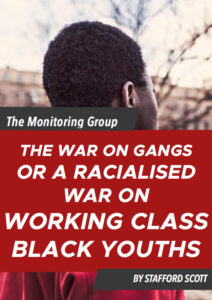The IRR welcomes Amnesty International and The Monitoring Group’s recent reports on the racially discriminatory nature of the Metropolitan Police Service’s Gangs Matrix intelligence database.
 The fact that the Information Commissioner’s Office has launched an investigation into whether the Metropolitan Police Service Trident Gangs Matrix breaches the Data Protection Act is welcome, but the dangers go beyond this.[1] The Home Office, local authorities and all other public sector agencies involved in the multi-agency approach to combating ‘gang-associated activity’ should, according to the IRR, review procedures to ensure that they are not contributing to a form of racialised data profiling that has serious repercussions for the human rights of young people, particularly black boys and young black men. For there is evidence to suggest we are witnessing a continuation of the ‘Windrush scandal’, only, this time it is the grandchildren of the Windrush generation that have been let down by the expansive scope of the ‘hostile environment’ precept, targeted now at inhabitants of certain neighbourhoods and particular estates in London and, in other areas of the UK.[2]
The fact that the Information Commissioner’s Office has launched an investigation into whether the Metropolitan Police Service Trident Gangs Matrix breaches the Data Protection Act is welcome, but the dangers go beyond this.[1] The Home Office, local authorities and all other public sector agencies involved in the multi-agency approach to combating ‘gang-associated activity’ should, according to the IRR, review procedures to ensure that they are not contributing to a form of racialised data profiling that has serious repercussions for the human rights of young people, particularly black boys and young black men. For there is evidence to suggest we are witnessing a continuation of the ‘Windrush scandal’, only, this time it is the grandchildren of the Windrush generation that have been let down by the expansive scope of the ‘hostile environment’ precept, targeted now at inhabitants of certain neighbourhoods and particular estates in London and, in other areas of the UK.[2]
Three years ago, Institute of Race Relations’ trustee Professor Lee Bridges described the Metropolitan Police’s Gangs Matrix intelligence database and the policing operations and practices, that utilise them, including ‘intelligence-led stop and search’, as ‘institutional racism in action’. Two reports published last week by Amnesty International and The Monitoring Group have advanced understanding of such racism in action.[3] In differing, but complementary ways, they reveal the logic and mechanics of structural racism and expose its founding narrative by David Cameron and Boris Johnson in 2011 that ‘urban gangs’ were to blame for the ‘riots’, and a war against ‘gangs culture’ was the solution.
At every stage – from the use of secret algorithms to calculate risk, to the disproportionate and discriminatory inclusion of so many young black men and boys on the Gang Matrix (99 of the 100 ‘gangsters’ listed on the Haringey Matrix are black) to the absence of any clear protocol for the review or removal of the names of those listed – these reports explore the ways in which processes of demonisation (of black urban youth culture) and racial stigmatisation (of specific estates) affect not just individuals, but whole communities. This racialised labelling creates ‘suspect communities’, and leaves many young black people dispossessed, ostracised, and excluded from society as the stigma of being a ‘gang nominal’ is reflected back at him as he goes about his daily life and tries to access services.
Both reports go beyond just dissecting flaws in policing; pinpointing in very precise ways the role played by government departments, spearheaded by the Home Office, in allowing racial profiling to spread across a range of institutions. Most telling is the unthinking ease with which a multitude of agencies – from the probation service to youth offending teams, from job centres to housing associations, from local authority to voluntary sector partner agencies, appear to have colluded in the racialised logic that underpins the Gangs Matrix.
Related links
IRR News: Lord Herman Ouseley on the Amnesty International Gangs Matrix report: Screwed by the system
IRR News: JENGbA responds to the Amnesty International report on the Gangs Matrix
Amnesty International report: Trapped in the matrix: Secrecy, stigma, and bias in the Met’s Gangs Database
The Monitoring Group report by Stafford Scott: The War on Gangs or a Racialised War on Working Class Black Youths

